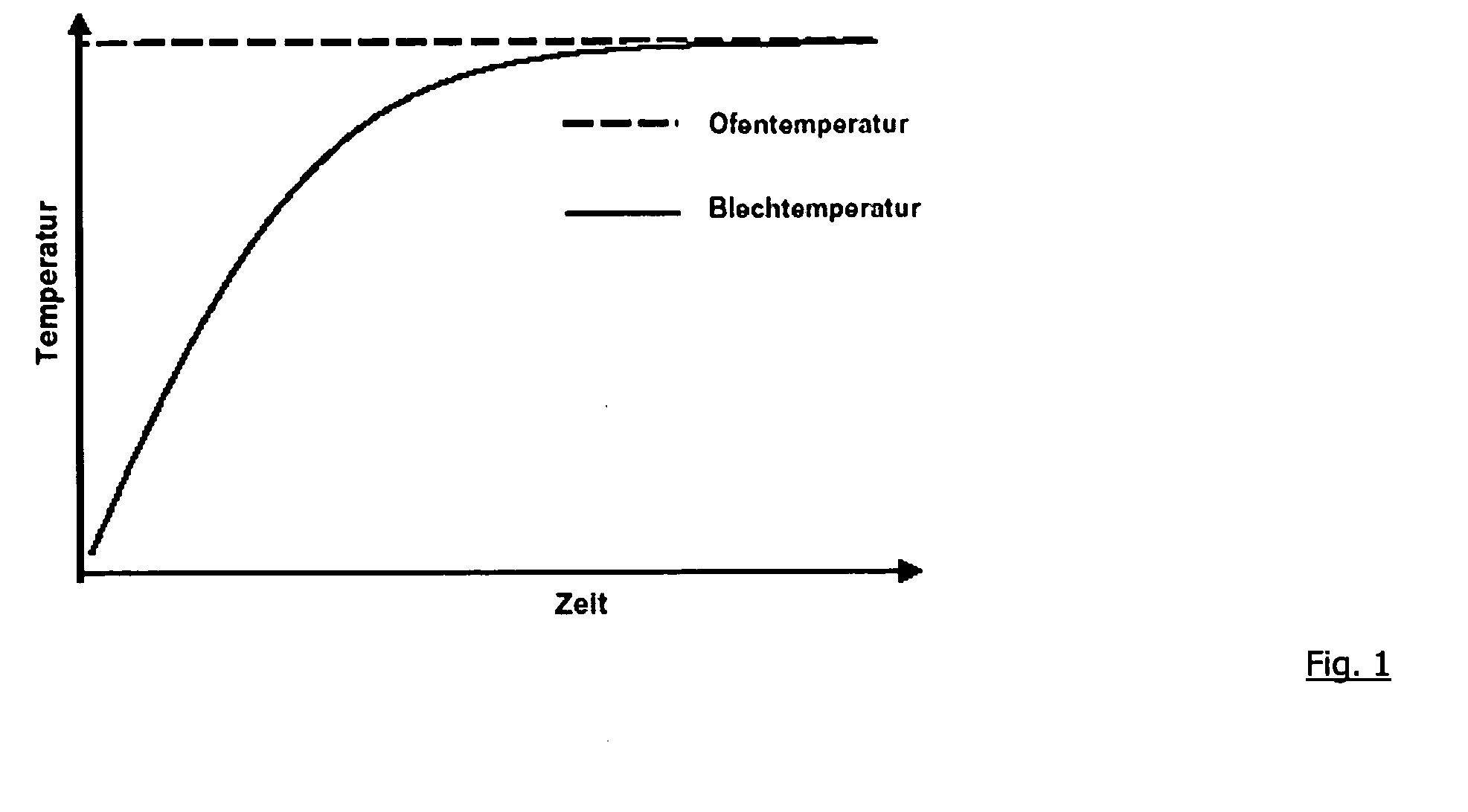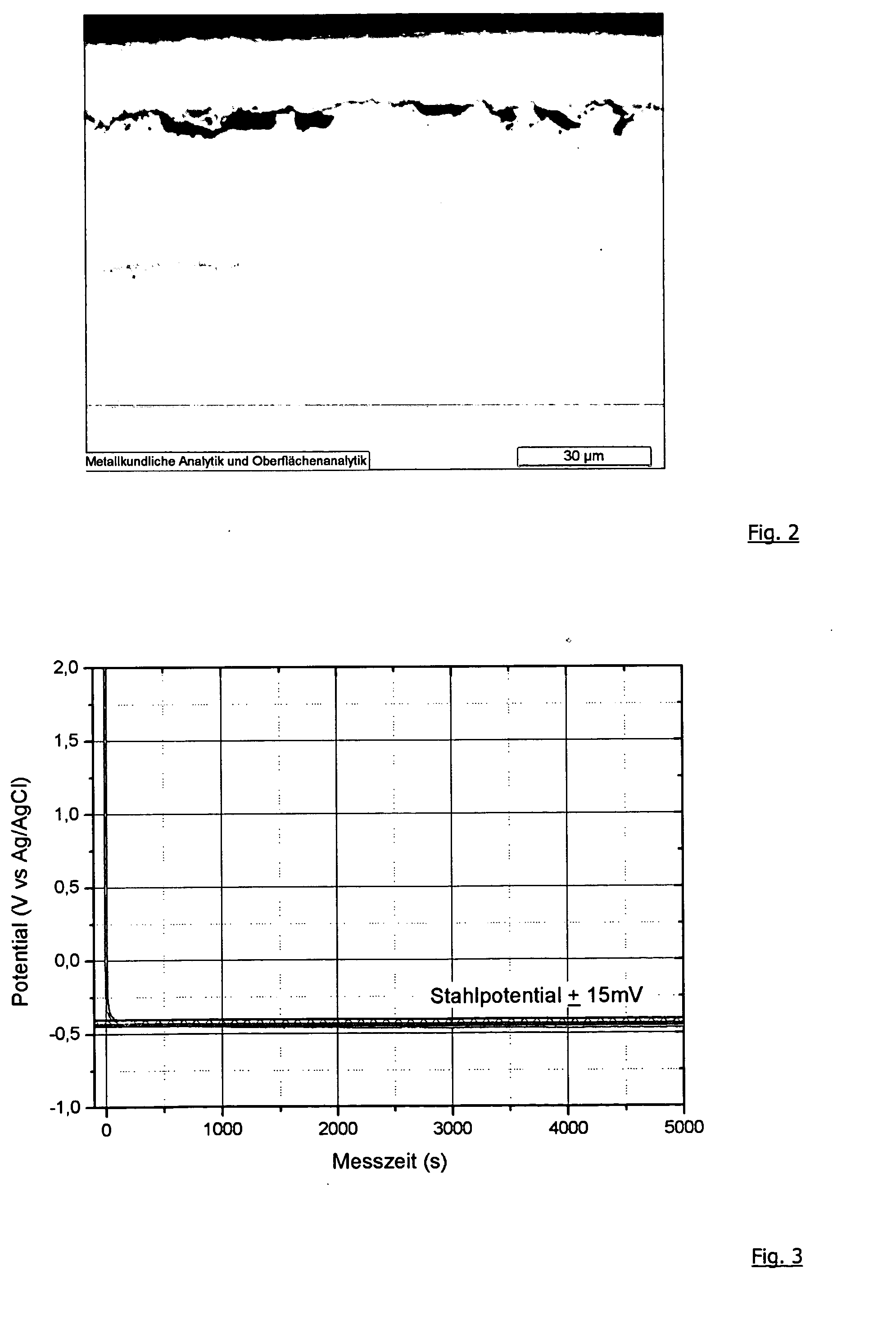Method for Producing a Hardened Steel Part
a technology of hardened steel and parts, applied in the direction of surface reaction electrolytic coating, solid-state diffusion coating, foundry mould, etc., can solve the problems of oxidation on the surface, measurable change in material, low-alloy steel sheets, etc., to prevent the rapid growth of an iron-zinc binding phase, inhibit the fe—zn diffusion, and reduce the tendency for iron-zinc diffusion
- Summary
- Abstract
- Description
- Claims
- Application Information
AI Technical Summary
Benefits of technology
Problems solved by technology
Method used
Image
Examples
example 1 (
NOT ACCORDING TO THE INVENTION)
[0073] A hot-dip aluminized steel sheet is produced by conveying a steel sheet through a liquid aluminum bath. When annealed at 900° C., the reaction of the steel with the aluminum coating produces an aluminum-iron surface layer. The correspondingly annealed sheet has a dark gray appearance; the surface is homogeneous and does not have any visually discernible defects.
[0074] The galvanostatic dissolution of the surface coating of the hot-dip aluminized sheet must have a very high potential (+2.8 V) at the beginning of the measurement in order to assure the current density of 12.7 mA / cm2. After a short measurement time, the required potential falls to the steel potential. It is clear from this behavior that an annealed sheet with a coating produced by hot-dip aluminization provides very efficient barrier protection. However, as soon as holes develop in the coating, the potential falls to the steel potential and damage to the base material begins to occ...
example 2 (
NOT ACCORDING TO THE INVENTION)
[0075] A steel sheet was covered with an aluminum-zinc coating by means of hot-dip galvanization, the molten metal being comprised of 55% aluminum, 44% zinc, and approx. 1% silicon. After the coating of the surface and a subsequent annealing at 900° C., a gray-blue surface without defects is observed. FIG. 4 depicts a transverse section.
[0076] The annealed material then undergoes the galvanostatic dissolution. At the beginning of the measurement, the material demonstrates an approx. −0.92 V potential required for dissolution, which thus lies significantly below the steel potential. This value is comparable to the potential required for dissolution of a hot-dip galvanized coating before the annealing process. But this very zinc-rich phase ends after only approx. 350 seconds of measurement time. Then there is a rapid increase to a potential that now lies just below the steel potential. After this coating is breached, the potential first falls to a value...
example 3 (
ACCORDING TO THE INVENTION)
[0077] A steel sheet is hot-dip galvanized in a heat melting bath of essentially 95% zinc and 5% aluminum. After annealing, the sheet has a silver-gray surface without defects. In the transverse section (FIG. 6), it is clear that the coating is comprised of a light phase and a dark phase, these phases representing Zn—Fe—Al-containing phases. The light phases are more zinc-rich and the dark phases are more iron-rich. Part of the aluminum reacts to the atmospheric oxygen during annealing and forms a protective Al2O3 skin.
[0078] In the galvanostatic dissolution, at the beginning of the measurement, the sheet has a potential required for dissolution of approx. −0.7 V. This value lies significantly below the potential of the steel. After a measurement time of approx. 1,000 seconds, a potential of approx. −0.6 V sets in. This potential also lies significantly below the steel potential. After a measurement time of approx. 3,500 seconds, this part of the coating ...
PUM
| Property | Measurement | Unit |
|---|---|---|
| thickness | aaaaa | aaaaa |
| temperature | aaaaa | aaaaa |
| temperature | aaaaa | aaaaa |
Abstract
Description
Claims
Application Information
 Login to View More
Login to View More - R&D
- Intellectual Property
- Life Sciences
- Materials
- Tech Scout
- Unparalleled Data Quality
- Higher Quality Content
- 60% Fewer Hallucinations
Browse by: Latest US Patents, China's latest patents, Technical Efficacy Thesaurus, Application Domain, Technology Topic, Popular Technical Reports.
© 2025 PatSnap. All rights reserved.Legal|Privacy policy|Modern Slavery Act Transparency Statement|Sitemap|About US| Contact US: help@patsnap.com



